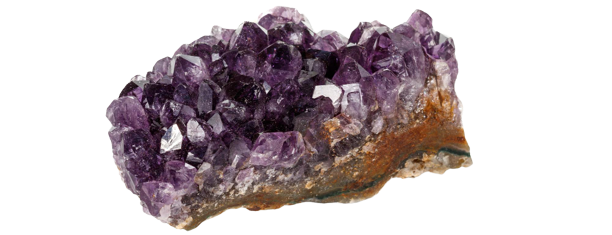Amethyst | February
Amethyst, as a member of a mineral family closely linked to its own, reveals a diverse array of colors. Delving into the unique color variations within this mineral species can provide invaluable insights.
Amethyst: The Majestic Gem of February
Amidst the vast expanse of time, as constellations wove their celestial narratives, a timeless tradition emerged, weaving a celestial connection with Earth – the world of birthstones. Crafted by visionaries such as Flavius Josephus, this lore forged an intimate link between zodiac constellations and earthly gemstones. From this cosmic ballet, under the mystical aura of February, steps forth Amethyst – a gem that doesn’t just glisten, but resonates with eons of history and the mystic heartbeat of the universe.
Imagine, through the lens of both ancient lore and contemporary science, a gemstone born deep within the Earth, crystallizing within the fiery embrace of the planet’s core. Forged by the Earth’s tumultuous geological forces, Amethyst stands as a testament to the resilience inherent in souls born in February. Its name derives from the Greek word ‘amethystos,’ meaning ‘not intoxicated,’ signifying sobriety and clarity of mind.
Throughout history, Amethyst has been cherished by civilizations around the world. The ancient Greeks and Romans believed it possessed protective qualities, warding off intoxication and harm. It adorned the regalia of nobility and found its place in royal jewelry, a symbol of wisdom and power.
With a spectrum of hues ranging from delicate lilacs to deep purples, Amethyst’s colors mirror the diverse personalities of those born in February. Modern science reveals that its color variation arises from impurities within its crystal lattice, yet each shade, both scientifically and symbolically, represents a unique facet of its wearer’s character.
Beyond its aesthetic allure, Amethyst transcends into the realms of modern science. It is prized by geologists as a window into our planet’s geological history and has found applications in everything from art to spirituality. Yet, at its core, it remains a gem of legends, dreams, and cosmic tales.
So, for souls touched by February’s enchantment, why Amethyst? Because it’s more than a gem; it’s a celestial bridge, an emblem of wisdom, and a vessel for both ancient folklore and scientific wonder.
In the embrace of Amethyst, one discovers the convergence of age-old myths, contemporary revelations, and the eternal rhythm of the cosmos.

Amethyst: The Enchanting Gem of February
Color Varieties: Amethyst is celebrated for its enchanting purple hues that range from delicate lilacs to deep purples. These variations in color result from different levels of iron impurities and radiation exposure, creating a spectrum of captivating shades within the purple spectrum.
Common Amethyst Varieties:
- Siberian Amethyst: Known for its intense royal purple color, often considered the most sought-after shade.
- Ametrine: A unique variety that combines amethyst’s purple with citrine’s golden hues, forming striking bicolor gemstones.
Formation and Occurrence: Amethyst typically forms in hydrothermal veins and cavities within igneous rocks, particularly in geodes and volcanic formations. It can also be found in metamorphic rocks and alluvial deposits. Brazil, Uruguay, and Zambia are renowned for producing some of the world’s most exquisite amethyst specimens.

Modern Uses: Amethyst remains highly popular in contemporary jewelry, known for its soothing and calming energy, making it a favorite choice in holistic healing and metaphysical practices. Amethyst, with its rich history and mystical allure, continues to be a beloved gemstone, offering an array of shades that captivate the hearts of those born in February and enthusiasts of exquisite jewelry.
Scientific Fact: "Amethyst's Geological Significance"

Amethyst’s purple hues are primarily attributed to the presence of iron impurities and radiation exposure during its formation. These geological processes, combined with the specific crystal structure of quartz, create the spectrum of colors that range from delicate lilacs to deep purples.
Geologists recognize amethyst as a significant indicator of past geological events, offering clues about the environment in which it formed. The presence of amethyst in certain geological formations helps scientists piece together the history of volcanic activities, hydrothermal processes, and mineralization in the Earth’s crust.
In addition to its geological importance, amethyst remains a gem of aesthetic and metaphysical significance, making it a truly remarkable gemstone that bridges the worlds of science, beauty, and spirituality.
